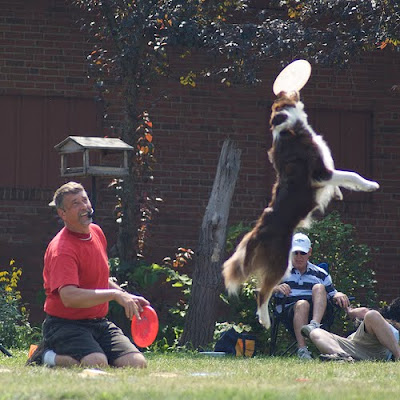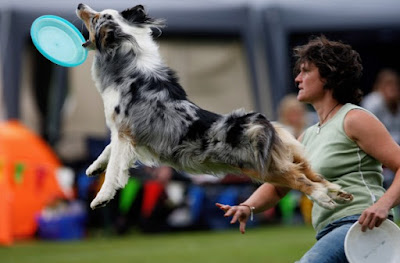
Frisbee with dogs is fundamentally a very simple activity, since only requires for you to throw the disc, let the dog catch it and retrieve back to you. The most attractive on this activity is it simplicity and fun that the owner and dog can take out of this sport.
Canine Frisbee is a very popular sport around the world and it goes from USA, where it began and has a huge amount of fans, to Europe, Japan and Australia.
As years went buy it suffered some changes, like adding some more demanding classes that evaluates among other distances, freestyles and jumping.
This sport began on USA, in Ohio, where a student (Alex Stein) and his dog (Asley Whippet) jump a fence at a nationally broadcast baseball game and started to play Frisbee with his dog. The exhibition had such a impact, that the baseball game was stop, and they started to announce the Frisbee action on the field. Only 8 minutes latter the student was escorted out of the field and arrested. It was this exhibition on national television that brought interest to this sport. (maybe this is an idea for us to do here !)
Some considerations that you should considered before starting this activity with your dog:

- Check your dog health with your vet. Jumps can make a potential hip or bone aggravated.
- The dog shouldn’t be extremely heavy (13 to 25 kg) and should be in shape.
- The prey instinct should be strong and also some retrieving should be present.
- Good temperament is a must, since the dog is free among people and other animals.
- Never star a jumping activity with a dog with less than 14 months, since jumping’s can harm the correct bone developing.
- Start some basic obedience for the dog not to run away, annoyed other people and stays near you.
- Choose a proper dog disc
- Always play in a safe area and don’t throw near holes, trees, fences or other potentially dangerous areas
After all this considerations you are ready to start Frisbee and, who knows, join a future national team (Hope is the last thing to die !).

Some good rules and division for this sport can be found on the Colorado Disc Dogs website (http://www.coloradodiscdogs.com/rules.html):
Basic Guidelines for Competition
- Keep your dog on a leash at all times when you are not competing or warming up. This saves you the embarrassment of having your dog run onto the field and interrupting the competition.
- Not all dogs, even well socialized ones, appreciate having other dogs in their space. Please be aware of what your dog is doing at the end of your 16-foot flexi-lead.
- Always pick up after your dog, and remind others to do the same. We try very hard to maintain good relations with the communities that allow us to host our events in their areas, and this is the main way we show our gratitude. Always leave the event site cleaner than you found it!
- As a courtesy to competitors, no food or treats of any kind are allowed on the competition field. Food dropped on the playing field may cause unnecessary distractions.
- Please exhibit good sportsmanship. This is a family sport, and we want our kids to be able to look up to you. Set a good example.
- NO female dogs in heat allowed at the competition site.
- Please treat your dog with respect. At the discretion of the contest coordinator, competitors who are seen to be mistreating their dogs will be asked to leave.
The four divisions that the CDD will offer at its events are: Novice, Intermediate, Advanced, and Open. On some occasions, a non-competitive Recreational division may be offered as well.
The Novice Division: The novice division has been, and will continue to be, a division for people new to the sport. However, people progress at different rates when they start going to competitions -- some people improve quickly, and others get better more gradually -- and the club recognizes this. To that end, we allow new teams to remain in the Novice division for two years. During their first year (365-day rule), a novice team may remain in the division no matter what results they put up. However, during their second year, if a team competing in Novice earns two "Top 3" finishes, they must immediately move up to a higher division.
It should be noted that new teams are not required to stay in Novice. They can move up into other divisions at ANY time.
(Note: The Rookie of the Year prize is still only for teams competing in their first SEASON, and the cut-off is still January 1. If you've competed prior to Jan. 1, with any dog, in any Frisbee event, you are NOT eligible for Rookie of the Year.)
Novice competitors will compete in two rounds* of Mini-Distance (also called Distance/Accuracy or Throw & Catch) getting 60 seconds in each round to make as many throws for their dog as possible using a single disc. Points are awarded for catches based on length of throw and whether the dog was in the air at the time of the catch. Upon registration, all novice competitors will receive an official disc. Novice competitors may then use this disc or most any other safe disc in competition, including floppies.
The Intermediate Division is for experienced teams who have been involved in the sport for more than a year (365 days), but are not ready for the Advanced Division yet. Intermediate competitors will compete in the same Mini-Distance format mentioned above. Intermediate competitors must use a standard competition disc (Wham-O Fastback Frisbee, Hero 235, Dogstar, or HyperFlite). Some events do provide 1 disc at sign-up, but competitors at this level and above need to provide their own discs. Official club discs will be available for sale on site for $3.00, with quantity discounts available.
Advanced and Open-For these 2 divisions, it is allowed for a competitor to enter both divisions with the same dog. The 1st round of MiniDistance in the Advanced division will count as the MiniDistance score in the Open division. Only teams that are "entered" into Advanced will do a second round of MiniDistance. PLEASE BE AWARE OF YOUR DOG'S CONDITION AND THEIR LIMITS. Summer competitions can quickly wear out both humans and dogs. Only enter both divisons, or consider sharing your dog, if you know your dog can handle it.
The Advanced Division is for the top MiniDistance teams. These teams are generally very experienced, but the division is open to anyone. Teams competing in Open will also do 1 round in the advanced division to satisfy their 1 round of MiniDistance for their Overall score.
The Open Division is for the most experienced teams and consists of one 90 second (Skyhoundz) or 120 second (UFO) round of Freestyle, and one 60 second round of Mini-Distance.
The MiniDistance round is also the first round of Advanced competition for those teams that wish to compete in that division.
Freestyle consists of a choreographed routine with your dog set to music, utilizing multiple discs and any and every type of throw and trick you can think of. This is where you routinely see vaults off the back, flips, spins, jumps, rolls, weaves, and many other amazing moves. Please see the official rules for either the UFO or Skyhoundz. New freestylers are always welcome, so if you think you can put on a good show, please don't hesitate to give it a try! Open competitors are also required to supply their own competition standard discs.
The Recreational Division is designed to be a non-competitive division, appealing to those who want to "just play" or perhaps gain a little more experience before trying a competition. The division is open to anyone, regardless of the experience level of handler or dog. There will only be a single 60 second Toss and Catch (MiniDistance) round for each team. The round will be scored according to the normal scoring rules for that event's format (UFO or SkyHoundz), but the teams will NOT be ranked, nor will there be a final standings posted, or prizes awarded. Upon request, competitors will receive a copy of their score sheet following the event, but it will not contain any final standings information. Since there are no standings, teams in the Rec Division will NOT earn Colorado Cup points.
* Depending on the number of teams registered in each division, the availability of enough space to run a second field, and whether there are enough qualified volunteers to run the second field, the event organizers may run a second field, or decide to limit participation in the Second Round to the top finishers of Round One. This decision will be made once registration is complete and announced prior to the beginning of Round One.
Other literature:
- European Dog Frisbee: http://www.dogfrisbee-europe.com/divisions_rules.php
- Getting Started on Frisbee: http://www.d-dog.com/Downloads/GettingStarted.pdf
Other dog sports:
- Herding: http://casacalado-dogsport.blogspot.com/2009/10/herding.html
- Obedience Competition: http://casacalado-dogsport.blogspot.com/2009/08/obedience-competition-team-sport.html
- Dock Dogs: http://casacalado-dogsport.blogspot.com/2009/08/dock-dogs-water-sport.html
- Water trial for Portuguese Water Dog: http://casacalado-dogsport.blogspot.com/2009/08/water-trial-for-portuguese-water-dog.html




